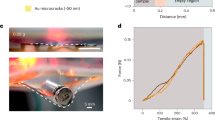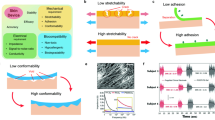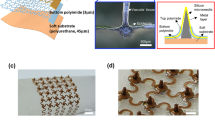Abstract
Skin-interfaced medical devices are critically important for diagnosing disease, monitoring physiological health and establishing control interfaces with prosthetics, computer systems and wearable robotic devices. Skin-like epidermal electronic technologies can support these use cases in soft and ultrathin materials that conformally interface with the skin in a manner that is mechanically and thermally imperceptible. Nevertheless, schemes so far have limited the overall sizes of these devices to less than a few square centimetres. Here, we present materials, device structures, handling and mounting methods, and manufacturing approaches that enable epidermal electronic interfaces that are orders of magnitude larger than previously realized. As a proof-of-concept, we demonstrate devices for electrophysiological recordings that enable coverage of the full scalp and the full circumference of the forearm. Filamentary conductive architectures in open-network designs minimize radio frequency-induced eddy currents, forming the basis for structural and functional compatibility with magnetic resonance imaging. We demonstrate the use of the large-area interfaces for the multifunctional control of a transhumeral prosthesis by patients who have undergone targeted muscle-reinnervation surgery, in long-term electroencephalography, and in simultaneous electroencephalography and structural and functional magnetic resonance imaging.
This is a preview of subscription content, access via your institution
Access options
Access Nature and 54 other Nature Portfolio journals
Get Nature+, our best-value online-access subscription
$29.99 / 30 days
cancel any time
Subscribe to this journal
Receive 12 digital issues and online access to articles
$99.00 per year
only $8.25 per issue
Buy this article
- Purchase on Springer Link
- Instant access to full article PDF
Prices may be subject to local taxes which are calculated during checkout





Similar content being viewed by others
Code availability
EEGLAB is freely available (http://www.sccn.ucsd.edu/eeglab/) under the GNU public license for non-commercial use and open source development, together with sample data, a user’s tutorial and extensive documentation. In-house MATLAB tools were adapted from the software tools developed at Duke University (https://wiki.biac.duke.edu/biac:tools) and are available on request.
Data availability
The authors declare that all data supporting the findings of this study are available within the paper and its Supplementary Information.
Change history
04 April 2019
In Fig. 4c of this Article, the scale bar units were incorrectly stated as ‘μV’; the correct units are ‘mV’. The figure has now been amended accordingly.
14 March 2019
In Fig. 4c of this Article originally published, the bottom y axis was incorrectly labelled as ‘MRI–ECG (μV)’; the correct label is ‘MRI/ECG’. In addition, in Fig. 4d, the bottom y axis was incorrectly labelled as ‘ECG (μV)’; the correct label is ‘ECG (mV)’. The scale bar units were also incorrectly stated as ‘mV’, the correct units are ‘μV’. The figure has now been amended accordingly.
References
Heikenfeld, J. et al. Wearable sensors: modalities, challenges, and prospects. Lab Chip 18, 217–248 (2018).
Rogers, J. A., Someya, T. & Huang, Y. Materials and mechanics for stretchable electronics. Science 327, 1603–1607 (2010).
Liu, Y., Pharr, M. & Salvatore, G. A. Lab-on-Skin: a review of flexible and stretchable electronics for wearable health monitoring. ACS Nano 11, 9614–9635 (2017).
Kim, D.-H. et al. Epidermal electronics. Science 333, 838–843 (2011).
Tian, L. et al. Flexible and stretchable 3ω sensors for thermal characterization of human skin. Adv. Funct. Mater. 27, 1701282 (2017).
Fan, J. A. et al. Fractal design concepts for stretchable electronics. Nat. Commun. 5, 3266 (2014).
Yeo, W.-H. et al. Multifunctional epidermal electronics printed directly onto the skin. Adv. Mater. 25, 2773–2778 (2013).
Webb, R. C. et al. Ultrathin conformal devices for precise and continuous thermal characterization of human skin. Nat. Mater. 12, 938–944 (2013).
Miyamoto, A. et al. Inflammation-free, gas-permeable, lightweight, stretchable on-skin electronics with nanomeshes. Nat. Nanotechnol. 12, 907–913 (2017).
Norton, J. J. S. et al. Soft, curved electrode systems capable of integration on the auricle as a persistent brain-computer interface. Proc. Natl Acad. Sci. USA 112, 3920–3925 (2015).
Jeong, J. W. et al. Materials and optimized designs for human-machine interfaces via epidermal electronics. Adv. Mater. 25, 6839–6846 (2013).
Xu, B. X. et al. An epidermal stimulation and sensing platform for sensorimotor prosthetic control, management of lower back exertion, and electrical muscle activation. Adv. Mater. 28, 4462–4471 (2016).
Won, S. M. et al. Recent advances in materials, devices, and systems for neural interfaces. Adv. Mater. 30, 1800534 (2018).
Minev, I. R. et al. Electronic dura mater for long-term multimodal neural interfaces. Science 347, 159–163 (2015).
Ullsperger, M. & Debener, S. (eds) Simultaneous EEG and fMRI: Recording, Analysis, and Application. (New York, Oxford University Press, 2010).
Ritter, P. & Villringer, A. Simultaneous EEG–fMRI. Neurosc. Biobehav. Rev. 30, 823–838 (2006).
MacIntosh, B. et al. Improving functional magnetic resonance imaging motor studies through simultaneous electromyography recordings. Hum. Brain Mapp. 28, 835–845 (2007).
Neuner, I., Arrubla, J., Felder, J. & Shah, N. J. Simultaneous EEG–fMRI acquisition at low, high and ultra-high magnetic fields up to 9.4 T: perspectives and challenges. Neuroimage 102, 71–79 (2014).
Matsumura, H. et al. Removal of adhesive wound dressing and its effects on the stratum corneum of the skin: comparison of eight different adhesive wound dressings. Int. Wound. J. 11, 50–54 (2014).
Lee, J. W. et al. Soft, thin skin-mounted power management systems and their use in wireless thermography. Proc. Natl Acad. Sci. USA 113, 6131–6136 (2016).
McAdams, E. T., Jossinet, J., Lackermeier, A. & Risacher, F. Factors affecting electrode–gel–skin interface impedance in electrical impedance tomography. Med. Biol. Eng. Comput. 34, 397–408 (1996).
Chi, Y. M., Jung, T. P. & Cauwenberghs, G. Dry-contact and noncontact biopotential electrodes: methodological review. IEEE Rev. Biomed. Eng. 3, 106–119 (2010).
Lee, S. M. et al. Self-adhesive epidermal carbon nanotube electronics for tether-free long-term continuous recording of biosignals. Sci. Rep. 4, (2014).
Kontturi, K., Murtomaki, L., Hirvonen, J., Paronen, P. & Urtti, A. Electrochemical characterization of human skin by impedance spectroscopy: the effect of penetration enhancers. Pharm. Res. 10, 381–385 (1993).
Kalia, Y. N. & Guy, R. H. The electrical characteristics of human skin in vivo. Pharm. Res. 12, 1605–1613 (1995).
Kuiken, T. A. et al. Targeted muscle reinnervation for real-time myoelectric control of multifunction artificial arms. JAMA 301, 619–628 (2009).
Chowdhury, R. H. et al. Surface electromyography signal processing and classification techniques. Sensors 13, 12431–12466 (2013).
Young, A. J., Hargrove, L. J. & Kuiken, T. A. The effects of electrode size and orientation on the sensitivity of myoelectric pattern recognition systems to electrode shift. IEEE Trans. Biomed. Eng. 58, 2537–2544 (2011).
Pan, L., Zhang, D., Jiang, N., Sheng, X. & Zhu, X. Improving robustness against electrode shift of high density EMG for myoelectric control through common spatial patterns. J. Neuroeng. Rehabil. 12, 110 (2015).
Young, A. J., Hargrove, L. J. & Kuiken, T. A. Improving myoelectric pattern recognition robustness to electrode shift by changing interelectrode distance and electrode configuration. IEEE Trans. Biomed. Eng. 59, 645–652 (2012).
Li, Q. X. et al. Improving robustness against electrode shift of sEMG based hand gesture recognition using online semi-supervised learning. 2016 International Conference on Machine Learning and Cybernetics. IEEE, 1, 344–349 (2016).
Keller, T. & Kuhn, A. Skin properties and the influence on electrode design for transcutaneous (surface) electrical stimulation. 2009 World Congress on Medical Physics and Biomedical Engineering. 492–495 (Springer, Heidelberg, 2009).
Kaczmarek, K. A., Webster, J. G., Bachyrita, P. & Tompkins, W. J. Electrotactile and vibrotactile displays for sensory substitution systems. IEEE Trans. Biomed. Eng. 38, 1–16 (1991).
Akhtar, A., Sombeck, J., Boyce, B. & Bretl, T. Controlling sensation intensity for electrotactile stimulation in human-machine interfaces. Sci. Robot. 3, 9770 (2018).
Ji, J., Porjesz, B., Begleiter, H. & Chorlian, D. P300: the similarities and differences in the scalp distribution of visual and auditory modality. Brain Topogr. 11, 315–327 (1999).
Singhal, A. et al. Electrophysiological correlates of fearful and sad distraction on target processing in adolescents with attention deficit-hyperactivity symptoms and affective disorders. Front. Integr. Neurosci. 6, 119 (2012).
Murray, M. M., Brunet, D. & Michel, C. M. Topographic ERP analyses: a step-by-step tutorial review. Brain Topogr. 20, 249–264 (2008).
Murray, M. M., De Lucia, M., Brunet, D. & Michel, C. M. in Brain Signal Analysis: Advances in Neuroelectric and Neuromagnetic Methods (ed. Handy, T. C.) 21–53 (MIT Press, Cambridge, 2009).
Muraja-Murro, A. et al. Forehead EEG electrode set versus full-head scalp EEG in 100 patients with altered mental state. Epilepsy Behav. 49, 245–249 (2015).
Huang, C.-S. et al. Knowledge-based identification of sleep stages based on two forehead electroencephalogram channels. Front. Neurosci. 8, 263 (2014).
Lin, C. T. et al. Forehead EEG in support of future feasible personal healthcare solutions: sleep management, headache prevention, and depression treatment. IEEE Access 5, 10612–10621 (2017).
Wei-Long, Z. & Bao-Liang, L. A multimodal approach to estimating vigilance using EEG and forehead EOG. J. Neural Eng. 14, 026017 (2017).
Lemieux, L., Allen, P. J., Franconi, F., Symms, M. R. & Fish, D. R. Recording of EEG during fMRI experiments: patient safety. Magn. Reson. Med. 38, 943–952 (1997).
Kuusela, L., Turunen, S., Valanne, L. & Sipilä, O. Safety in simultaneous EEG-fMRI at 3 T: temperature measurements. Acta Radiol. 56, 739–745 (2015).
Lopez-Calderon, J. & Luck, S. J. ERPLAB: an open-source toolbox for the analysis of event related potentials. Front. Hum. Neurosci. 8, 213 (2014).
Taylor, R. Interpretation of the correlation coefficient: a basic review. J. Diagn. Med. Sonog. 6, 35–39 (1990).
Ansys HFSS User’s Guide (Ansys Inc., 2012).
Lenzi, T., Lipsey, J. & Sensinger, J. W. The RIC Arm—a small anthropomorphic transhumeral prosthesis. IEEE ASME Trans. Mechatron. 21, 2660–2671 (2016).
Delorme, A. & Makeig, S. EEGLAB: an open source toolbox for analysis of single-trial EEG dynamics including independent component analysis. J. Neurosci. Methods 134, 9–21 (2004).
Dolcos, F. & McCarthy, G. Brain systems mediating cognitive interference by emotional distraction. J. Neurosci. 26, 2072–2079 (2006).
Iordan, A. D. & Dolcos, F. Brain activity and network interactions linked to valence-related differences in the impact of emotional distraction. Cereb. Cortex 27, 731–749 (2017).
Acknowledgements
Device fabrication and development were carried out in part in the Frederick Seitz Materials Research Laboratory Central Research Facilities and Micro-Nano-Mechanical Systems Cleanroom, University of Illinois. L.T. acknowledges the support from Beckman Institute Postdoctoral Fellowship at UIUC. The materials and device engineering aspects of the research were supported by the Center for Bio-Integrated Electronics at Northwestern University. MRI experiments were performed at the Biomedical Imaging Center at the Beckman Institute, which also provided pilot hour support. K.J.Y. acknowledges the support from the National Research Foundation of Korea (grant nos NRF-2017R1C1B5017728 and NRF-2018M3A7B4071109) and the Yonsei University Future-leading Research Initiative (grant nos RMS2 2018-22-0028). Z.X. acknowledges the support from National Natural Science Foundation of China (grant no. 11402134). Y.H. acknowledges the support from NSF (grant nos 1400169, 1534120 and 1635443). J.W.L. gratefully acknowledges support from National Research Foundation of Korea (grant nos NRF-2017M3A7B4049466 and NRF-2018R1C1B5045721). M.M. acknowledges the support provided by Beckman Institute Predoctoral and Postdoctoral Fellowships. F.D. acknowledges the support provided by a Helen Corley Petit Scholarship in Liberal Arts and Sciences and an Emanuel Donchin Professorial Scholarship in Psychology from the University of Illinois. The authors would like to thank F. Lam for valuable discussions on electromagnetic simulations. We thank representatives of BrainVision LLC and Easycap GmbH for helpful conversations related to the equipment adaptations required for this project.
Author information
Authors and Affiliations
Contributions
L.T., B.Z., A.A., K.J.Y. and J.A.R. designed the project. L.T., B.Z., B.M., K.E.M, M.F. and G.G. conceived and performed long-term EEG studies. L.T., A.A., J.C., M.F., T.B. and L.J.H. conceived and performed EMG experiments on patients for prosthesis control. L.T., B.Z., M.M., R.J.L., J.A.F. and F.D. performed simultaneous electrophysiological recordings and MRI. J.W.L., J.L., Y.L., S.Q., J.Z. and P.V.B. assisted in the fabrication of devices and materials characterization. X.G., J.W., Z.X., Y.M., Y.Z. and Y.H. performed the mechanical and electromagnetic simulations. L.T., B.Z., A.A., M.M. and J.A.R. wrote the manuscript and K.E.M, R.J.L., J.A.F. J.W., Y.H. and F.D. provided feedback on the manuscript.
Corresponding author
Ethics declarations
Competing interests
The authors declare no competing interests
Additional information
Publisher’s note: Springer Nature remains neutral with regard to jurisdictional claims in published maps and institutional affiliations.
Supplementary information
Supplementary Information
Supplementary figures, tables and references.
Supplementary Video 1
Signals obtained with the epidermal EMG array allow an amputee to control elbow, wrist and hand movements on the prosthesis.
Supplementary Video 2
Robustness of motion classification on vigorous tapping on the electrodes.
Rights and permissions
About this article
Cite this article
Tian, L., Zimmerman, B., Akhtar, A. et al. Large-area MRI-compatible epidermal electronic interfaces for prosthetic control and cognitive monitoring. Nat Biomed Eng 3, 194–205 (2019). https://doi.org/10.1038/s41551-019-0347-x
Received:
Accepted:
Published:
Issue Date:
DOI: https://doi.org/10.1038/s41551-019-0347-x
This article is cited by
-
Electrospinning of nanofibres
Nature Reviews Methods Primers (2024)
-
The wearable electronic patch that’s impervious to sweat
Nature (2024)
-
A three-dimensional liquid diode for soft, integrated permeable electronics
Nature (2024)
-
Sweat-permeable electronic skin with a pattern of eyes for body temperature monitoring
Micro and Nano Systems Letters (2023)
-
Artificial intelligence enhanced sensors - enabling technologies to next-generation healthcare and biomedical platform
Bioelectronic Medicine (2023)



